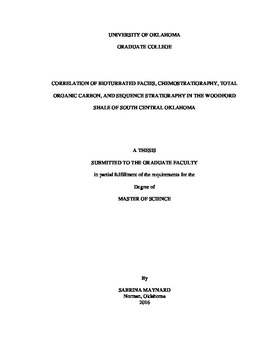| dc.contributor.advisor | Slatt, Roger | |
| dc.contributor.author | Maynard, Sabrina | |
| dc.date.accessioned | 2016-12-12T16:18:03Z | |
| dc.date.available | 2016-12-12T16:18:03Z | |
| dc.date.issued | 2016-12 | |
| dc.identifier.uri | https://hdl.handle.net/11244/47028 | |
| dc.description.abstract | Bioturbation creates a physical change in the primary rock structure and mineralogy. It is evidence of past life in the sediments and can assist in determining the depositional environment. Organisms once lived and fed in the strata, consuming organic matter and leaving traces that were filled with material different from the surrounding sediment. Bioturbation is an important factor in reservoir characterization as it has been shown to affect porosity and permeability, be a direct indicator of bottom water oxygen conditions, and with a high enough occurrence, have a direct correlation to total organic carbon content of the sediment. The importance of mudstones (shales) has been recognized for over a century, but they still remain largely understudied.
Technological advances in handheld X-Ray Fluorescence (HHXRF) have been instrumental in demonstrating the utility of chemostratigraphic data to create higher order sequence stratigraphic interpretations. This study seeks to identify the correlation between chemostratigraphy, bioturbation, total organic carbon, and sequence stratigraphy of the Woodford Shale of south-central Oklahoma through the utilization of HHXRF and X-Ray Diffraction (XRD) technologies.
Ichnofossils are identified through detailed core descriptions which are then correlated to the elemental and mineralogical data of the host strata obtained through HHXRF and XRD technologies, respectively. Although individual elements can give valuable information, multiple proxies are used to give the best overall correlation despite exceptions to the standards that are present. Molybdenum and Vanadium are used in conjunction with other proxies to correlate bottom water anoxia because their presence is directly affected by the level of basin restriction that exists – the more restricted the basin the less trace metal supply being put into the water column which could lead to misinterpretation of bottom water conditions. This correlation will allow for more confident bioturbation identification of the reservoir, and thus aid in the identification of changing levels of bottom water anoxia during reservoir characterization as well as provide quantitative support for the presence of bioturbation in what is typically considered a homogenous deep water black shale. These associations are then tied to wells lacking HHXRF data by correlating with core gamma-ray logs and calculated elemental curves for potassium, uranium, and thorium, thus expanding the higher order sequence stratigraphy to wells lacking chemostratigraphic data. | en_US |
| dc.language | en_US | en_US |
| dc.rights | Attribution-NonCommercial-NoDerivs 3.0 United States | * |
| dc.rights.uri | https://creativecommons.org/licenses/by-nc-nd/3.0/us/ | * |
| dc.subject | Chemostratigraphy, Bioturbation, Sequence Stratigraphy, Woodford Shale | en_US |
| dc.title | Correlation of Bioturbated Facies, Chemostratigraphy, Total Organic Carbon, and Sequence Stratigraphy in the Woodford Shale of South Central Oklahoma | en_US |
| dc.contributor.committeeMember | Elmore, Douglas | |
| dc.contributor.committeeMember | Jordan, Douglas | |
| dc.date.manuscript | 2016-12-08 | |
| dc.thesis.degree | Master of Science | en_US |
| ou.group | Mewbourne College of Earth and Energy::Conoco Phillips School of Geology and Geophysics | en_US |
| shareok.nativefileaccess | restricted | en_US |

